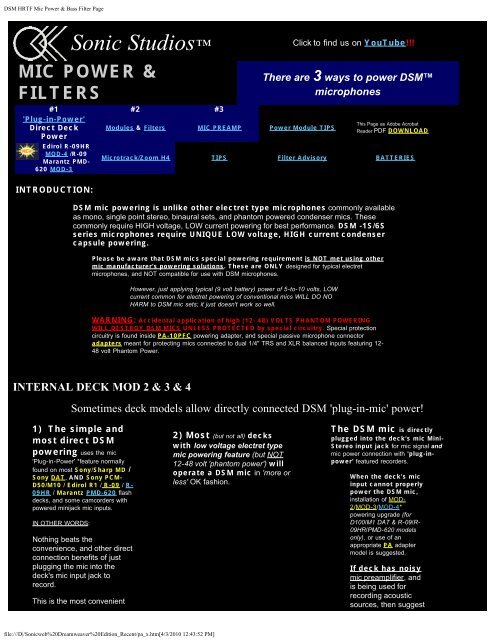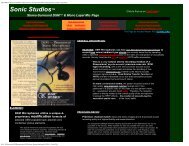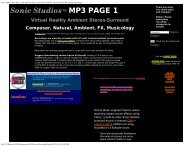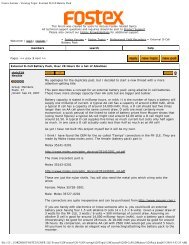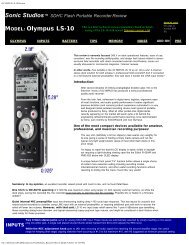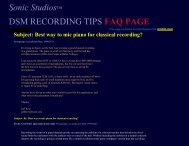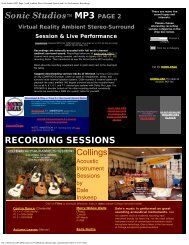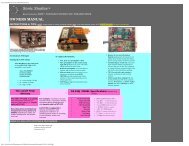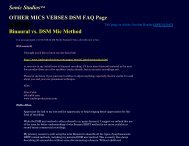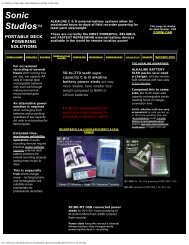DSM HRTF Mic Power & Bass Filter Page - Sonic Studios
DSM HRTF Mic Power & Bass Filter Page - Sonic Studios
DSM HRTF Mic Power & Bass Filter Page - Sonic Studios
You also want an ePaper? Increase the reach of your titles
YUMPU automatically turns print PDFs into web optimized ePapers that Google loves.
<strong>DSM</strong> <strong>HRTF</strong> <strong>Mic</strong> <strong>Power</strong> & <strong>Bass</strong> <strong>Filter</strong> <strong>Page</strong><br />
<strong>Sonic</strong> <strong>Studios</strong><br />
MIC POWER &<br />
FILTERS<br />
Click to find us on YouTube!!!<br />
There are 3 ways to power <strong>DSM</strong><br />
microphones<br />
#1 #2 #3<br />
'Plug-in-<strong>Power</strong>'<br />
This <strong>Page</strong> as Adobe Acrobat<br />
Direct Deck Modules & <strong>Filter</strong>s MIC PREAMP <strong>Power</strong> Module TIPS<br />
Reader PDF DOWNLOAD<br />
<strong>Power</strong><br />
Edirol R-09HR<br />
MOD-4 /R-09<br />
Marantz PMD-<br />
620 MOD-3<br />
<strong>Mic</strong>rotrack/Zoom H4 TIPS <strong>Filter</strong> Advisory BATTERIES<br />
INTRODUCTION:<br />
<strong>DSM</strong> mic powering is unlike other electret type microphones commonly available<br />
as mono, single point stereo, binaural sets, and phantom powered condenser mics. These<br />
commonly require HIGH voltage, LOW current powering for best performance. <strong>DSM</strong> -1S/6S<br />
series microphones require UNIQUE LOW voltage, HIGH current condenser<br />
capsule powering.<br />
Please be aware that <strong>DSM</strong> mics special powering requirement is NOT met using other<br />
mic manufacturer's powering solutions. These are ONLY designed for typical electret<br />
microphones, and NOT compatible for use with <strong>DSM</strong> microphones.<br />
However, just applying typical (9 volt battery) power of 5-to-10 volts, LOW<br />
current common for electret powering of conventional mics WILL DO NO<br />
HARM to <strong>DSM</strong> mic sets; it just doesn't work so well.<br />
WARNING: Accidental application of high (12- 48) VOLTS PHANTOM POWERING<br />
WILL DESTROY <strong>DSM</strong> MICS UNLESS PROTECTED by special circuitry. Special protection<br />
circuitry is found inside PA-10PFC powering adapter, and special passive microphone connector<br />
adapters meant for protecting mics connected to dual 1/4" TRS and XLR balanced inputs featuring 12-<br />
48 volt Phantom <strong>Power</strong>.<br />
INTERNAL DECK MOD 2 & 3 & 4<br />
Sometimes deck models allow directly connected <strong>DSM</strong> 'plug-in-mic' power!<br />
1) The simple and<br />
most direct <strong>DSM</strong><br />
powering uses the mic<br />
'Plug-in-<strong>Power</strong>' *feature normally<br />
found on most Sony/Sharp MD /<br />
Sony DAT, AND Sony PCM-<br />
D50/M10 / Edirol R1 / R-09 / R-<br />
09HR / Marantz PMD-620 flash<br />
decks, and some camcorders with<br />
powered minijack mic inputs.<br />
IN OTHER WORDS:<br />
Nothing beats the<br />
convenience, and other direct<br />
connection benefits of just<br />
plugging the mic into the<br />
deck's mic input jack to<br />
record.<br />
This is the most convenient<br />
2) Most (but not all) decks<br />
with low voltage electret type<br />
mic powering feature (but NOT<br />
12-48 volt 'phantom power') will<br />
operate a <strong>DSM</strong> mic in 'more or<br />
less' OK fashion.<br />
The <strong>DSM</strong> mic is directly<br />
plugged into the deck's mic Mini-<br />
Stereo input jack for mic signal and<br />
mic power connection with 'plug-inpower'<br />
featured recorders.<br />
When the deck's mic<br />
input cannot properly<br />
power the <strong>DSM</strong> mic,<br />
installation of MOD-<br />
2/MOD-3/MOD-4*<br />
powering upgrade (for<br />
D100/M1 DAT & R-09/R-<br />
09HR/PMD-620 models<br />
only), or use of an<br />
appropriate PA adapter<br />
model is suggested.<br />
If deck has noisy<br />
mic preamplifier, and<br />
is being used for<br />
recording acoustic<br />
sources, then suggest<br />
file:///D|/<strong>Sonic</strong>web%20Dreamweaver%20Edition_Recent/pa_x.htm[4/3/2010 12:43:52 PM]
<strong>DSM</strong> <strong>HRTF</strong> <strong>Mic</strong> <strong>Power</strong> & <strong>Bass</strong> <strong>Filter</strong> <strong>Page</strong><br />
'all-in-one-deck' + <strong>DSM</strong> mic<br />
portable recording system<br />
Correct, direct <strong>DSM</strong> powering as purchased stock<br />
EXCEPTIONS are SONY's PCM-D50 and LATEST PCM-<br />
M10 models. These two flash deck models POWER <strong>DSM</strong> MICS<br />
PERFECTLY, AND have adequately quiet internal mic preamplifier !!!!<br />
for noise-free results<br />
an external PA-3SX or<br />
PA-24NJ preamp for<br />
both powering the<br />
mic, and improving<br />
the audio<br />
quality/versatility over<br />
common noisy, gainlimited<br />
internal deck<br />
preamps.<br />
WHAT IS MOD-2 UPGRADE for<br />
Sony DAT Models?:<br />
The upgrade places additional<br />
surface mounted components (SMC)<br />
'in-tandem' with the existing Sony<br />
circuit to boost the mic supply<br />
performance specific to <strong>DSM</strong> mic<br />
powering. Nothing else is changed<br />
AND Sony has honored (to this date)<br />
all warranty/services agreements<br />
regardless of having this upgrade<br />
installed.<br />
I did have only two occasions<br />
(in 10 years) where there was need to<br />
send Sony the upgrade's technical<br />
details describing the true scope of the<br />
upgrading procedure in response to a<br />
temporary denial of honoring an<br />
extended warranty service contract.<br />
SONY DAT decks are sent here;<br />
48 hour turnaround for MOD-2<br />
service upgrade.<br />
NOTE: MOD-2 doesn't affect<br />
warranty, serviceability, or shorten<br />
the battery running time by more<br />
than a few minutes.<br />
Typical MOD-2 mic powering battery<br />
drain is LESS THAN 1/150th of the<br />
total deck power.<br />
MOD-2 upgrade is $125 USD for<br />
TCD-D100 & PCM-M1 DAT.<br />
EDIROL R-09/R-09HR & MARANTZ PMD-620 MOD-3/4 <strong>DSM</strong> POWERING<br />
UPGRADE<br />
R-09 was the first,then PMD-620, and now my current favorite Edirol R-<br />
09HR flash models are practical for internal mic power circuitry upgrade for direct<br />
'plug-in-mic-powering' of <strong>DSM</strong> mics.<br />
STOCK R-09, R-09HR, PMD-620 are NOT compatible for<br />
working direct connection powering of <strong>DSM</strong> microphone; TOO much<br />
current is applied causing mic to not operate.<br />
MOD-3/4 internal deck upgrade increases current control so <strong>DSM</strong><br />
mic operates simply plugged into the MIC minijack input. <strong>Mic</strong> power<br />
is then turned on using the deck's menu.<br />
MOD-3/4 is recommended for recording applications needing<br />
simplicity of lowest profile/size of deck+mic two piece recording<br />
gear where internal noise performance of the deck is not an issue.<br />
Having R-09, R-09HR, or PMD-620 upgraded is<br />
suggested for recording moderate low-to-extreme loudness<br />
ambient/effects, and musical sounds. And when the modest noise<br />
performance of deck's internal mic preamplifier is found adequate<br />
for the intended purpose.<br />
MOD Upgrade Service<br />
file:///D|/<strong>Sonic</strong>web%20Dreamweaver%20Edition_Recent/pa_x.htm[4/3/2010 12:43:52 PM]
<strong>DSM</strong> <strong>HRTF</strong> <strong>Mic</strong> <strong>Power</strong> & <strong>Bass</strong> <strong>Filter</strong> <strong>Page</strong><br />
R-09 + MOD-3 Upgrade + <strong>DSM</strong>-6S/EL stereo mic might be<br />
THE most compact, highest quality, and longest running<br />
2-PIECE BLUES/POP/ROCK recording system available.<br />
R-09/R-09HR: $150 USD + Shipping<br />
(if outside USA)<br />
PMD-620: $125 USD + Shipping (if<br />
outside USA)<br />
NOTE: MOD-3 upgrade service ONLY; R-09 deck and <strong>DSM</strong> mic shown above NOT included<br />
R-09HR MOD-4 <strong>DSM</strong> POWERING<br />
UPGRADE<br />
$150 USD<br />
INCLUDES USA SHIPPING<br />
While LINE input using external<br />
PA-3SX preamplifier (shown here)<br />
both powers <strong>DSM</strong> mics, and<br />
removes virtually all noise/audio<br />
quality concerns, there's logistical,<br />
cost advantage to having a simpler<br />
deck+mic 2-piece recording rig.<br />
MOD-4 internal deck<br />
modification allows full<br />
performance <strong>DSM</strong> mic powering for<br />
having the most compact high<br />
definition recording system<br />
possible.<br />
Usual past mic powering<br />
MOD-1/2/3 did little or nothing in<br />
reducing deck mic input noise<br />
issues if any existed for a particular<br />
deck model.<br />
R-09HR using MOD-4 is different<br />
in also reducing this deck's micpower<br />
ON excessive/audible low<br />
frequency noise to be virtually<br />
identical to the mic-power OFF<br />
noise level.<br />
DRILL DEEPER INTO MOD-4 AND CUSTOM GEAR MODIFICATION IN THIS TS THREAD<br />
NOTE: The following few 'blue colored' sections mostly discuss vintage recorders not usually in service these days, but<br />
may be of interest to a few recordists who still own or find these models on the used market..<br />
Edirol R1 solid state recorder (out of production), TCD-D7/D8 DAT deck<br />
models, (and SBM-1 Accessory; ALL out of production) have low current for <strong>DSM</strong><br />
powering. However, these models are still OK to directly power a <strong>DSM</strong> mic in a<br />
consistent manner without external mic powering solutions, but marginal powering<br />
performance of these decks is suggested mostly for lower audio quality requirements.<br />
(NOTE: R1's internal preamplifier is also a bit too noisy for most low loudness 'natural<br />
acoustic' sounds.)<br />
EXCEPTION IS SONY PCM-D50 AND LATEST PCM-M10 as ONLY two STOCK flash<br />
decks to FULLY POWER <strong>DSM</strong> MICS CORRECTLY.<br />
This is NOT true for TCD-D100/PCM-M1 models (out of production) ALWAYS<br />
requiring MOD-2* upgrade for consistent low distortion recording for ability to use<br />
direct-connected mic powering method. TCD-D100/PCM-M1 mic powering feature is<br />
unique in being way, way 'too low in supply current' for consistent <strong>DSM</strong> mic powering.<br />
NOTE: Sony SBM-1 Portable Digital Processor DAT accessory & MZ-<br />
R30/37/50/55/90 MiniDisc recording decks mostly DO NOT require MOD-2<br />
as the stock mic powering is a little weak, but good enough for consistent<br />
<strong>DSM</strong> recording quality. This is NOT true of later Sony MD models often with<br />
too little available mic power for consistent <strong>DSM</strong> mic performance.<br />
MOD-2* and<br />
newer MOD-<br />
3/4 direct mic<br />
powering are<br />
internal deck<br />
upgrades now<br />
only available<br />
for TCD-<br />
D100 & PCM-<br />
M1 Sony<br />
DAT, and<br />
Edirol/Roland<br />
R-09/R-09HR,<br />
Marantz PMD-<br />
620 flash decks.<br />
ALSO, PA-3SX<br />
preamp provides<br />
simple <strong>DSM</strong><br />
powering, and most<br />
advanced precision<br />
<strong>DSM</strong> mic powering is<br />
found in all PA-24 series<br />
of portable mic<br />
preamplifier.<br />
file:///D|/<strong>Sonic</strong>web%20Dreamweaver%20Edition_Recent/pa_x.htm[4/3/2010 12:43:52 PM]
<strong>DSM</strong> <strong>HRTF</strong> <strong>Mic</strong> <strong>Power</strong> & <strong>Bass</strong> <strong>Filter</strong> <strong>Page</strong><br />
Just plugging-in a <strong>DSM</strong> mic into 'most' Sony MD/DAT, and Edirol (talking R-1 only) miniportable<br />
recorders will allow a <strong>DSM</strong> "to operate" (like you'll be able to record), but performance<br />
varies from sufficiently OK to NOT OK manner sometimes causing distorted (or indeterminate)<br />
performance at unexpected times if the deck is under-powering the mic set.<br />
While the 1.5-2.5 volts available at the mic jack in Sony decks is fine<br />
for full performance with <strong>DSM</strong> (but NOT for ordinary electrets that work best with<br />
5-10 volts or higher), the 'direct-from-stock-deck' power issue with <strong>DSM</strong> series mics is<br />
<strong>DSM</strong> needs up to 10 times MORE 'current' or amperage than is usual for common<br />
electrets from other manufacturers.<br />
Other recorder models (like Edirol R-1, Aiwa, and Sony/Canon camera) with mic 'plugin-power'<br />
features are again, generally usable, but with the same problems of<br />
indeterminate <strong>DSM</strong> performance; some work OK, but others are too weak<br />
supplying needed more mic powering current for consistent performance.<br />
Stock Roland/Edirol R-09/R-09HR, and Marantz PMD-620 mic input-jack powering<br />
feature will NOT work for direct <strong>DSM</strong> mic powering unless MOD-3 or MOD-4 upgrade<br />
is installed.<br />
In other words,<br />
conventional<br />
electret microphone<br />
work best at<br />
HIGHER voltage<br />
NOT found in<br />
portable decks, but<br />
are happy ONLY<br />
with the low current<br />
that is found in<br />
these same decks.<br />
<strong>DSM</strong> mics<br />
work best<br />
with LOW<br />
voltage found<br />
in 'Plug-in-<br />
<strong>Power</strong>' portable<br />
decks, but need<br />
much HIGHER<br />
current than<br />
most electret<br />
type mics; just<br />
the OPPOSITE<br />
of conventional<br />
condenser type<br />
microphones.<br />
KNOWN: Stock (analog cassette) WM-D3/D6C mic power is weak (for powering the <strong>DSM</strong> mic) while the D7/8 decks<br />
is much better, but NOT (nearly) good enough for full <strong>DSM</strong> performance.<br />
Sony MZ-R30/37/50/55/90 & SBM-1 powering is OK or mostly good enough ...<br />
The <strong>DSM</strong> mic powering ability of Sony MD and HiMD portable decks is<br />
unknown, there just too many models to individually acquire for bench testing. I have had<br />
several reports of direct <strong>DSM</strong> mic powering problems with MZ-R700 and later. Using a<br />
PA adapter solved audible distortion complaints.<br />
I think in general Sony MD<br />
models are not very good for<br />
<strong>DSM</strong> mic powering or at least greatly<br />
suspect to not being adequate.<br />
ANY SHARP MiniDISC MODEL (with mic input) is the only stock portable deck<br />
(found) that directly powers <strong>DSM</strong> mics nearly PERFECTLY just 'as supplied stock by<br />
Sharp'.<br />
NOTE: Sharp USA distributed/warranty<br />
MD decks are no longer available.<br />
#2) IN-SERIES PA <strong>Mic</strong> <strong>Power</strong>ing & <strong>Bass</strong> Reduction<br />
<strong>Filter</strong>s<br />
'Standard' PA mic power/filter models use 3.5 mm mini-stereo<br />
input jacks that fit 'standard' <strong>DSM</strong>-1S/6S series mics.<br />
New version PA-10PFC adapter (shown at left) shows upgraded<br />
miniXLR input connection optional (+$50) on all PA adapters<br />
and <strong>DSM</strong> mic preamplifier models.<br />
Using a simple <strong>Bass</strong> filter during recording is much preferred to<br />
file:///D|/<strong>Sonic</strong>web%20Dreamweaver%20Edition_Recent/pa_x.htm[4/3/2010 12:43:52 PM]
<strong>DSM</strong> <strong>HRTF</strong> <strong>Mic</strong> <strong>Power</strong> & <strong>Bass</strong> <strong>Filter</strong> <strong>Page</strong><br />
The second method of<br />
<strong>DSM</strong> MIC powering allows<br />
a 'Low Cut' bass reduction<br />
filter.<br />
post graphic equalization during playback as graphic equalizers tend to<br />
reduce the recording quality of the upper frequencies even when control<br />
frequencies are set at zero or 0 DB.<br />
For Example, voice interviews conducted near the rumble of nearby motor traffic<br />
can be made much clearer sounding by using an 85 cycle (or higher) <strong>Bass</strong> reduction<br />
filter.<br />
A PA model with low cut filter reduces excessive bass sounds for cleaner sounding recording .<br />
A 'Lo-Cut' filter (a.k.a., 'Hi-Pass' filter) controls excessive low frequencies during the<br />
recording process. A benefit depending on the type of sound/music of interest, and may also depend on<br />
low frequency ambient sounds competing with the recorded subject of main interest.<br />
NOTE: Decks with MOD-2/3 upgrade can also be used with any PA-xx module when OCCASIONALLY<br />
REQUIRING effective low frequency reduction controlling feature.<br />
PA-6LC2 .... 85 Cycle <strong>Bass</strong> <strong>Filter</strong> .... Switch<br />
Defeatable<br />
The PA-6LC2 is one of the more versatile of the<br />
PA-x <strong>DSM</strong> external powering accessories for<br />
recording contemporary live Jazz, POP/Rock, and Blues<br />
performances where Ambient and/or PA Speakers produce<br />
occasional excessive/boomy bass making recordings muddy<br />
sounding when played on most moderate powered stereo<br />
systems.<br />
The 85 LoCUT Switch allows full (MAX) bass whenever BASS<br />
reduction is not desired as for acoustic recording.<br />
DESCRIPTION OF BASS REDUCTION MODELS<br />
1) PA-6LC2 with 85 cycle bass filter that can be turned OFF. This model is very good for those who also record<br />
amplified acoustic-to-jazz where no bass filter is needed, and also very good for recording moderate to fairly loud pop/rock<br />
(but not too close to speakers) where 85 cycle bass filter is maybe best to turn ON.<br />
2) PA-6LC3 with low-to-moderate 40-80-120 cycle bass filter switch selections. Good for amplified acousticto-moderately<br />
loud pop/rock (but not too close to speakers). <strong>Filter</strong> is always ON at selected setting.<br />
3) PA-6LC3B adapter is best solution for moderate-to-very loud rock (especially in Japan/Germany) with 85-<br />
170-250 cycle bass filter switch selections. This model is very needed if recording very near to speakers. <strong>Filter</strong> is always<br />
turned ON at selected setting.<br />
<strong>DSM</strong> MIC POWER & BASS FILTER MODELS:<br />
INPUT JACK TYPE<br />
PA-6 standard models have 3.5mm 'Mini-Stereo' mic input jack/Right-Angle molded output plug, but $30-perconnector<br />
pro miniXLR option should be considered for most reliable mic connections.<br />
3.5 mm miniXLR-3<br />
BASS<br />
FILTERS<br />
Standard <strong>DSM</strong> MIC power; uses (1) AA alkaline type cell<br />
PA-6<br />
$125.- $155.-<br />
(ONLY)<br />
PA-6LC Fixed pop/rock 85Hz bass filter...always on $150.- $180.-<br />
PA-6LC2 ON/OFF 85Hz bass filter; best for acoustic/standard pop/rock<br />
40/80/120Hz <strong>Bass</strong> LoCut; for little to moderate excessive<br />
PA-6LC3<br />
bass<br />
$225.- $255.-<br />
85/180/250 Cycle LoCut; for moderate to extreme excessive<br />
PA-6LC3B<br />
bass<br />
PA-10XP<br />
Unbalanced type molded dual right-angle 1/4" TRS output<br />
plugs<br />
$250.- $280.-<br />
PA-10PFC Unbalanced type dual XLR-3 output connectors $250.- $280.-<br />
PA-<br />
True balanced dual miniXLR-5F input jack; balanced XLR<br />
$650.-<br />
file:///D|/<strong>Sonic</strong>web%20Dreamweaver%20Edition_Recent/pa_x.htm[4/3/2010 12:43:52 PM]
<strong>DSM</strong> <strong>HRTF</strong> <strong>Mic</strong> <strong>Power</strong> & <strong>Bass</strong> <strong>Filter</strong> <strong>Page</strong><br />
10DXLR5<br />
PA-13<br />
outputs<br />
For DPA-4060; (2) 9 Volt Lithium; PWR ON LED, 0/20dB Attn,<br />
<strong>Bass</strong> LoCut<br />
$750-<br />
SPECIFICATIONS CHART<br />
MODEL<br />
COST<br />
(USD)<br />
POWER<br />
CELL<br />
CELL<br />
½LIFE<br />
OUTPUT<br />
PLUG<br />
(Input)<br />
CORD<br />
LENGTH<br />
Hi-Pass<br />
Switch?<br />
1 st -3<br />
db Hi-<br />
Pass<br />
2 d -3 db<br />
Hi-<br />
Pass<br />
3 rd -3 db<br />
Hi-Pass<br />
AC<br />
Coupling<br />
Method<br />
Min.<br />
Z<br />
Load<br />
Nom.<br />
Z<br />
Load<br />
Comments<br />
PA-6 $125<br />
PA-6LC $150<br />
PA-6LC2 $225<br />
Mini-<br />
PA-<br />
6LC3(B)<br />
PA-6PFC<br />
PA-5PFC<br />
PA-10XP<br />
PA-<br />
10PFC<br />
$225<br />
$250<br />
(1)AA<br />
Alkaline<br />
(or L91<br />
Lithium)<br />
(1)AA<br />
Alkaline<br />
(or L91)<br />
1,000 Hr<br />
(or 2000<br />
w/L91)<br />
2,000 Hr (or<br />
4000<br />
w/L91)<br />
(1)3.5 mm<br />
(1/8")<br />
Stereo<br />
(2)¼"Mono<br />
(2)¼" TS<br />
R/A Molded<br />
(2)XLR-3 M<br />
2½ ft<br />
Newer<br />
'Box-type'<br />
PA<br />
adapters<br />
with 8-10"<br />
output<br />
cords<br />
6<br />
INCHES<br />
NO<br />
YES<br />
NO<br />
9 cycles 85<br />
n/a<br />
cycles<br />
9 cycles 80(180)<br />
40(85) cycles<br />
cycles<br />
15<br />
cycles<br />
n/a<br />
n/a<br />
120(250)<br />
cycles<br />
n/a<br />
10% Tant.<br />
.25%<br />
Precision<br />
Matched<br />
Film<br />
2000<br />
Ohms<br />
or<br />
Higher<br />
Normal<br />
@<br />
4700<br />
Ohms<br />
Universal<br />
<strong>Bass</strong>y Rock<br />
filter on/off<br />
3-pos.toggle<br />
Purist Sys.<br />
Semi-Pro<br />
For Zoom H4, <strong>Mic</strong>rotrack<br />
24/96 Low Profile Dual TRS<br />
1/4" Input<br />
Pro-Studio<br />
PA-<br />
(2)XLR-3 M<br />
10DXLR5 $650 (2)AAA 1,000 Hr (miniXLR-5F<br />
INPUT)<br />
10<br />
INCHES<br />
9 cycles 10% Tant<br />
Professional-Digital Portable<br />
XLR Input Decks<br />
PA-9/PFC $450 (2)3.6 V 450 Hr / max<br />
1/8" Mini-<br />
2½ ft YES<br />
Stereo<br />
9 cycles 45 cycles *-15 db<br />
f/DPA-4060<br />
10%Tant.&<br />
PA-<br />
Atten / sw.<br />
.25% Film 5,000 10,000 $500 (4)6<br />
13/PFC<br />
V / Li 350 Hr / max f/<strong>DSM</strong>-13<br />
PA-6LCxx User Mode vs. -3 dB Frequency, & '<strong>Bass</strong>-Boom' Reduction Factor<br />
Model<br />
PA-6LC<br />
PA-6LC2<br />
PA-6LC3<br />
PA-<br />
6LC3B<br />
Hz @<br />
ADDITIONAL NOTES AND COMMENTS<br />
#1 #2 #3<br />
-3dB Switch Position<br />
*USER MODE<br />
85<br />
MIC(1)<br />
110 PA-3SX(2)<br />
n/a<br />
65 LINE(3)<br />
-5 DB B/B(4)<br />
8 85<br />
MIC<br />
8 110 PA-3SX<br />
n/a<br />
8 65 LINE<br />
none -5 DB B/B<br />
35 70 100 MIC<br />
55 100 125 PA-3SX<br />
20 55 85 LINE<br />
-2 DB -5 DB -8 DB B/B<br />
85 170 250 MIC<br />
110 210 275 PA-3SX<br />
65 130 200 LINE<br />
-5 DB -10 DB -12 DB B/B<br />
*USER MODE describes the effects on the -3 db frequency<br />
rolloff point with:<br />
(1) <strong>DSM</strong> MIC > PA adapter > Deck's MIC input<br />
(2) <strong>DSM</strong> MIC > PA adapter > PA-3SX preamp input ><br />
Deck's LINE input<br />
(3) <strong>DSM</strong> MIC > PA adapter > Deck's LINE input (MOST<br />
USEFUL for post-reduction of excessive low frequency bass<br />
sounds on already made recordings)<br />
(4) B/B describes the 'MEGA'-<strong>Bass</strong>-Boom reducing<br />
factor in Decibels at the most common occurring frequency<br />
range of 50-60 Cycles Only during recording a live event.<br />
PA-6LC3B is a more effective version of the PA-6LC3 for reduction of 'Single<br />
Note Mega-Boom' <strong>Bass</strong> (like that heard from many Hi-<strong>Power</strong> Auto-Truck<br />
custom stereo installations) found at heavy metal Rock/Pop music venues.<br />
Newer 'closed-box-type' PA modules now have option of Switchcraft<br />
file:///D|/<strong>Sonic</strong>web%20Dreamweaver%20Edition_Recent/pa_x.htm[4/3/2010 12:43:52 PM]
<strong>DSM</strong> <strong>HRTF</strong> <strong>Mic</strong> <strong>Power</strong> & <strong>Bass</strong> <strong>Filter</strong> <strong>Page</strong><br />
unbalanced mini-XLR-3F (single 3-pin).<br />
New model PA-10DXLR5 is only adapter with true balanced<br />
input/output. This adapter uses Switchcraft mini-XLR-5F (dual 5-pin;<br />
shown at left) input jack connection.<br />
PA-10XP <strong>Mic</strong> Module for <strong>Mic</strong>rotrack & Zoom H4<br />
UPDATE 3/18/2007<br />
The <strong>Mic</strong>roTrack & Zoom H4 decks will NOT<br />
directly power <strong>DSM</strong> stereo-surround<br />
microphones.<br />
$280 USD (as<br />
shown with<br />
MiniXLR)<br />
<strong>DSM</strong> mic powering requires at least in-series PA-<br />
6 mic powering into <strong>Mic</strong>rotrack's limited gain 1/8" stereo<br />
jack, or PA-10XP into <strong>Mic</strong>rotrack or Zoom deck's two 1/4"<br />
TRS inputs.<br />
PA-10XP also protects against accidental MIC damage<br />
from applied phantom power ON/OFF feature of these<br />
model decks. NOTE: Zoom H4 deck has dual balanced XLR mic level only input, BUT unbalanced 1/4" TS jacks are both<br />
mic/line input for this deck.<br />
Advanced <strong>DSM</strong> mic power is using active PA-24NJ-XP preamplifier model for line level<br />
input to most decks with TRS line level input ability. Also see: MT24/96 and ZOOM H4 deck<br />
reviews<br />
<strong>Power</strong>ing adapters use either 1/8" minijack input of<br />
MT24/96, or modified dual molded output plug into more<br />
versatile dual TRS 1/4" mic/line input.<br />
Dual balanced TRS input seems at least better<br />
for advantage of deck's fullest mic level gain selections not<br />
available on MT24/96 using minijack input.<br />
Using TRS input gives far more versatility for recording of<br />
pure acoustic sounds to very bass-loud music venue range.<br />
See also: MT24/96 DECK REVIEW<br />
PA MODULE INTERNAL BATTERY INSTRUCTIONS<br />
NO need to open! NEW alkaline AA battery is inside and ready to work for 1000 to<br />
2000+ hours or change for new after 2 - 3 years.<br />
Please remember NO On/0ff switch. Suggest unplug <strong>DSM</strong> mic same day after using,<br />
then battery is off and lasts for very long time.<br />
If you (accidentally) leave <strong>DSM</strong> mic connected, then change 1 AA alkaline battery<br />
every 2-3 months.<br />
USING PA-6(xxx) FILTER MODELS INTO 3.5 MM MICROTRACK INPUT<br />
file:///D|/<strong>Sonic</strong>web%20Dreamweaver%20Edition_Recent/pa_x.htm[4/3/2010 12:43:52 PM]
<strong>DSM</strong> <strong>HRTF</strong> <strong>Mic</strong> <strong>Power</strong> & <strong>Bass</strong> <strong>Filter</strong> <strong>Page</strong><br />
Example: For pop/rock amplified venues of various types, suggest (models with bass filter) PA-6LC, 2, 3,<br />
or 3B models powering adapter. These adapters will connect directly to the <strong>Mic</strong>rotrack's stereo minijack<br />
input with standard right/angle molded 3.5 mm stereo plug.<br />
However, if desiring multiple gain selection advantage of using <strong>Mic</strong>rotrack<br />
24/96 TRS mic inputs, similar (output) modified PA adapters (w/accidental high voltage<br />
'phantom power' protection circuit) are available as +$75 PA-model with dual R/A molded TS<br />
plug option. Those owning standard PA adapters who now wish to use MT24/96 TRS inputs<br />
may purchase $75 minijack-to-dual TRS (protected) cable adapter.<br />
Both modified PA model,<br />
or separate minijack-to-<br />
TRS plug protected cable<br />
adapter have low profile<br />
molded TRS 1/4" plugs<br />
(above photo).<br />
TIPS SECTION<br />
BASS FILTER AT PA-3SX PREAMP OUTPUT<br />
In a message dated 10/6/04 5:06:41 PM Pacific Daylight Time, txxx@tkd.att.ne.jp writes:<br />
(NOTE: 8/2007 edit update allowing more current deck model/accurate filter configuration information)<br />
Hi,<br />
I purchased <strong>DSM</strong>-6/L, and PA-6LC3B last year. Thank you for at that time.<br />
User-friendliness is good, and sound quality is also clear and is satisfied<br />
very much.<br />
I want to carry out hard disk or flash recording shortly.<br />
So, there is a question about a preamplifier. Although PA-24NJ and PA-3SX<br />
are introduced to the Home<strong>Page</strong>, is a difference only the existence of a base<br />
cut filter?<br />
Please give me advice.<br />
thanks,<br />
Txxxxi Oxxx<br />
Hello Txxx,<br />
PA-24NJ has over twice the circuit complexity, twice available gain, over 3 octaves<br />
more frequency bandwidth, power on indication, and has a bass filter feature as<br />
compared to simple, lower costing PA-3SX.<br />
However, the PA-3SX is very capable for your purpose with three gain selections,<br />
and ON/OFF power switch control, has identical LOW Battery/CLIP indicator like<br />
with PA-24NJ. PA-3SX also powers the <strong>DSM</strong> mic, but in less sophisticated way as<br />
compared to precision current source circuit of 24NJ.<br />
See preamplifiers at: http://www.sonicstudios.com/access.htm#micamp<br />
PA-3SX preamplifier with 20/28/36 dB gain selection is very good for using with new<br />
CF and hard disk recorders requiring LINE level input for quality low noise<br />
recording.<br />
IF bass filter is also needed, then first connect <strong>DSM</strong> mic directly to PA-6LC(+) mic<br />
powering bass filter input, then filter output to PA-3SX preamp input, and then<br />
connect PA-3SX PREAMP OUTPUT plug to deck's line input. This will allow having<br />
full function of PA-6LC3B bass reduction filter working with <strong>DSM</strong> + PA-6LC3B + PA-<br />
3SX system. Used in this way, the (1) AA battery inside the PA-6LC3B filter<br />
module is powering the <strong>DSM</strong> mic continually until unplugged from the filter module.<br />
So remember to unplug mic when not using it as there is no mic power ON/OFF<br />
switch like on the the PA-3SX preamplifier.<br />
Please be aware that there is still going to be a change in filter<br />
frequency from what is shown on PA-6LC3B switch label. Refer to the<br />
CHART showing new filter frequency settings with PA-3SX preamplifier<br />
This is because MIC input impedance of PA-3SX preamplifier is lower than usual<br />
for most deck MIC inputs, but is also very close to using Edirol/Roland R-09 stock<br />
deck with MIC POWER TURNED ON in the menu; see 'alternate configuration'<br />
below.<br />
ALTERNATE R-09 CONFIGURATION: With PA filter adapter output connected<br />
file:///D|/<strong>Sonic</strong>web%20Dreamweaver%20Edition_Recent/pa_x.htm[4/3/2010 12:43:52 PM]
<strong>DSM</strong> <strong>HRTF</strong> <strong>Mic</strong> <strong>Power</strong> & <strong>Bass</strong> <strong>Filter</strong> <strong>Page</strong><br />
directly to R-09 MIC input (no PA-3SX preamp); turning OFF R-09 mic power<br />
decreases input loading, so PA filter does not reduce bass as much, meaning filter<br />
frequency (cycles/Hz) is now lower than shown on PA filter label. So with R-09 mic<br />
power off, you might want to use next higher filter setting as filters are now less<br />
aggressive to reduce bass sounds. Suggest best way to use PA filter directly into<br />
R-09 deck mic input jack is with R-09 mic power ON so bass filter works better to<br />
reduce bass. And filter frequency is nearly same as is shown with PA-3SX preamp<br />
input connection.<br />
In other words, you can use PA bass filter connected directly <strong>DSM</strong><br />
mic and then filter output to PA-3SX preamplifier and get good LINE<br />
level for recorder, and also you can connect your PA-6LC3B directly to MIC<br />
input on deck (with/without mic power turned on) to get desired excessive bass<br />
reduction function while recording.<br />
Please let me know when ready to order. Cost of PA-3SX with EMS shipping is<br />
$475.00USD.<br />
Send prepayment as before.<br />
See payment/ship for outside USA at: http://www.sonicstudios.com/ordering.htm<br />
Best Regards in Sound & Music Recording,<br />
Leonard (& Debbie) Lombardo, Owners<br />
OLDER MODEL PA ADAPTER TIP<br />
IN-SERIES PA adapter modules are for powering <strong>DSM</strong> mics; some have low-cut bass filters<br />
The 3.5 mm input Jack should be kept from<br />
disconnection or movement by using one of the<br />
two moveable cord securing straps as illustrated in<br />
the two photos.<br />
NOTE: Newer PA-6LC2 and other 'newer box'<br />
type PA adapters have short 8-10 inch length<br />
output cords, and are not supplied with cord<br />
securing straps.<br />
BASS FILTER ADVISORY<br />
It seems that "a bit too much that bass filtering" is an easy thing to do when all you got to do is<br />
slide a switch and viola! ........ there's now less bass in the recording. <strong>Mic</strong>rophone BASS <strong>Filter</strong>ing can be a good<br />
thing to even up the overall "tone" balance of a recording AND it also gives more analog input or recording<br />
"headroom" that helps to enhance the overall resolution of higher frequencies.<br />
In other words, you can turn up the REC level a lot more FOR MIDS AND HIGHS because the<br />
strongest (bass) sound component is now at a much lower deck input level.<br />
Sometimes it's not that you can do it (reduce the bass content with a filter), but it's really about<br />
knowing WHEN and WHEN NOT and HOW MUCH TO reduce bass sounds. If the sound is SO loud<br />
that your hearing gets distorted OR if you are prudent in saving your ears with wearing earplugs (especially when<br />
right-up close to the stacks), you MAY NOT be HEARING the overall tonal balance of the venue WELL ENOUGH<br />
TO MAKING the most appropriate bass filter selection.<br />
Too many recordings I've lately heard seem to error on WAY TOO<br />
MUCH BASS FILTERING as to lose most sense of the real "GUT and emotional<br />
file:///D|/<strong>Sonic</strong>web%20Dreamweaver%20Edition_Recent/pa_x.htm[4/3/2010 12:43:52 PM]
<strong>DSM</strong> <strong>HRTF</strong> <strong>Mic</strong> <strong>Power</strong> & <strong>Bass</strong> <strong>Filter</strong> <strong>Page</strong><br />
FEELing" of the music; this is big part of the live sound that I personally find important.<br />
However, very "thin sounding recordings" are MORE OFTEN caused by POST BASS<br />
<strong>Filter</strong>ing in a digital sound editing (DAW) program than by the use of real-time<br />
microphone filtering, but both mechanisms can do equal damage or benefit to a<br />
recording DEPENDING.<br />
That's 'Depending' on your own taste in sound preferences and 'depending' on<br />
what's the most important aspects of a particular music style. For example; Maybe<br />
some Metal Rock styles are most cherished by the majority of their fans for that<br />
'screaming in-you-face' guitar/vocals style that is impossible to hear from being buried<br />
in massive bass sounds if played 'straight' on home stereos. Lose most of the bass by<br />
filtering and you'll get the "in-your-face" guitar/vocal aspect much easier with regular<br />
good quality consumer playback gear. The only problem is it's a bit on the thin sound<br />
side of live, but the more important aspects of the music is most accessible to fans.<br />
QUESTION: Would you THINK to strip the 'Gut Thumping <strong>Bass</strong>' sound out of REGGAE music?<br />
Well, of course you could, either during the recording with a mic filter OR afterwards with POST in pure<br />
digital editing.<br />
But, before you do it, please try to remember that a big part of Reggae and African music IS THE<br />
POWERFUL BASS Sounds.<br />
Of Course THERE ARE TIMES when you really NEED OR SHOULD<br />
(and maybe ONLY SLIGHTLY) reduce the <strong>Bass</strong> to achieve a better<br />
balance between a 'live sound' feel and what's going to work with most<br />
speaker playback systems we have at home or automobile.<br />
Just be careful to not take away too much low frequency sound that the "ambient or live feel" of the<br />
recording is inaccessible by a thin and over processed sounding recording.<br />
<strong>Mic</strong>rophone TIP:<br />
Use deck ONLY in 20 dB (LOW sensitivity) mic input setting. Adjust using only full Manual<br />
record level adjust (no limiter) for VU levels to average at -12 dB VU; momentary bass peaks<br />
recorded only to -4 dB VU maximum level. This is for getting cleanest sounding recording.<br />
See tips page for more<br />
PA adapter battery:<br />
Use new AA alkaline (only this type) battery inside (PA + battery shipped ready to use). When<br />
replacing PA battery, make sure + terminal polarity is correct as shown. You DO NOT need to<br />
remove battery when not using. Unplugging mic from PA input jack turns OFF the battery<br />
power, but do not plug anything (like PA output plug into input PA jack) when not using. AA<br />
battery will last over 2000 hours in use and up to 2 years when placed in storage or when<br />
nothing is plugged into the PA input jack.<br />
BASS Reduction TIP:<br />
Amount of <strong>Bass</strong> reduction (choice of filter frequency setting on PA adapter) will depend on the<br />
venue live sound, and also where you are sitting or positioned when recording. If you find the<br />
recording has too little bass sound, then remember where filter switch was set and adjust for<br />
less reduction next time in similar sounding live venue situation.<br />
Recordings with too little bass (where bass was reduced by filter too much or deemphasized<br />
to sound too thin) can be fully restored using opposite 6 dB per octave<br />
'emphasis' starting at the filter frequency used when making the recording; less<br />
than 6 dB/octave bass emphasis is suggested when full bass restoration is too<br />
much bass for balanced sound and for practical playback with normal speaker<br />
systems.<br />
There is no liability for recording quality if emphasis is done expertly, recordings<br />
actually sound better when computer editing emphasis process is needed and then<br />
applied properly.<br />
This is because less bass recorded (reduced by bass filtering) means general<br />
recording level can be increased (level knob turned up several notches when<br />
making the live recording) so mid-to-high frequency audio details are digitized<br />
file:///D|/<strong>Sonic</strong>web%20Dreamweaver%20Edition_Recent/pa_x.htm[4/3/2010 12:43:52 PM]
<strong>DSM</strong> <strong>HRTF</strong> <strong>Mic</strong> <strong>Power</strong> & <strong>Bass</strong> <strong>Filter</strong> <strong>Page</strong><br />
(digital conversion process in the deck) with greater accuracy (more audio detail).<br />
In other words, you can restore bass sound reduced by bass filter during the live recording<br />
(to personal taste) using careful digital editing software. This will allow the edited recording to<br />
sound better (full sounding bass) and tonally balanced when played back on home speakers.<br />
© Copyright 1998-2010 <strong>Sonic</strong> <strong>Studios</strong> All Rights Reserved This page modified 2/28/2010<br />
What's on <strong>Sonic</strong> <strong>Studios</strong> Web Site? (Click underlined text, and navigation photos)<br />
Home <strong>Page</strong><br />
<strong>DSM</strong><br />
Patented Stereo-Surround <strong>Mic</strong>rophone<br />
Technology<br />
Passive <strong>DSM</strong> <strong>Mic</strong> <strong>Power</strong>ing/<strong>Bass</strong> <strong>Filter</strong>s<br />
Eyegear/Headband/<strong>HRTF</strong> Baffle<br />
mountable matched omni mics<br />
Stops wind blast noise; transparent<br />
acoustic design; records real wind<br />
sounds<br />
for MD, DAT, CF, HD, and Video Field/Event/Studio Recording<br />
Battery <strong>Power</strong>ed-Portable <strong>Mic</strong> Preamplifiers<br />
High-definition, low noise, very wide<br />
bandwidth preamp designs to fit any<br />
field/event/studio application using <strong>DSM</strong><br />
stereo-surround mics.<br />
<strong>HRTF</strong><br />
RECORDING<br />
Stereo-Surround Omni<br />
<strong>Mic</strong> Baffle for Stand,<br />
Fishpole, Studio Boom,<br />
and Ceiling<br />
RECORDING ACCESSORIES<br />
Portable<br />
Deck<br />
<strong>Power</strong><br />
Solutions<br />
Patch/Adapter<br />
Cables<br />
MONO ONLY 'Lombardo'<br />
Lapel <strong>Mic</strong> for interview,<br />
Narration, Lecture, and<br />
clip-on acoustic instrument<br />
Recording<br />
Field/Studio<br />
Monitoring<br />
Headphones,<br />
Reviews<br />
<strong>DSM</strong> Magazine Reviews<br />
Recording Tips YouTube USA Toll Free: 1-877-347-6642<br />
FAQ Index <strong>Page</strong><br />
Pro Customers +<br />
Links<br />
Customer<br />
Comments<br />
A Few Other Links<br />
About <strong>Sonic</strong> <strong>Studios</strong><br />
Sample <strong>DSM</strong><br />
Recordings <strong>Page</strong><br />
Film-Video-Games<br />
Credits <strong>Page</strong><br />
Telephone #: 541-459-8839<br />
E-mail:<br />
Guy<strong>Sonic</strong>@aol.com<br />
Mail Ordering Options<br />
AVOID ACCIDENTAL E-MAIL SPAM<br />
DELETION:<br />
PLEASE .................. ALWAYS INCLUDE<br />
an appropriate SUBJECT LINE in all e-mail<br />
correspondence.<br />
(Return to the PA-x Chart)<br />
file:///D|/<strong>Sonic</strong>web%20Dreamweaver%20Edition_Recent/pa_x.htm[4/3/2010 12:43:52 PM]


